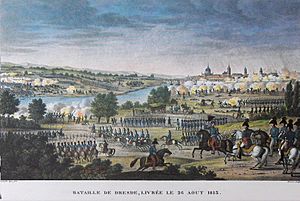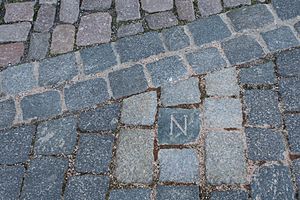Battle of Dresden facts for kids
Quick facts for kids Battle of Dresden |
|||||||
|---|---|---|---|---|---|---|---|
| Part of the German campaign of the Sixth Coalition | |||||||
 Battle of Dresden by Carle Vernet and Jacques François Swebach |
|||||||
|
|||||||
| Belligerents | |||||||
| Commanders and leaders | |||||||
| Strength | |||||||
| 100,000 135,000 |
200,000 215,000 |
||||||
| Casualties and losses | |||||||
| 10,000 killed or wounded | 38,000 14,000 killed or wounded, 24,000 captured, 40 guns |
||||||
The Battle of Dresden was a huge fight that happened on August 26–27, 1813, during the Napoleonic Wars. It took place near the city of Dresden in what is now Germany. In this battle, French forces led by Napoleon won a victory against a much larger army. This larger army was made up of soldiers from Austria, the Russian Empire, and Prussia. They were all part of the Sixth Coalition, a group of countries trying to push Napoleon's French army out of Central Europe.
Even though Napoleon won, his victory didn't completely break up the Coalition. Bad weather and smart moves by the Russian army stopped Napoleon from chasing them down. Just three days after this battle, the Coalition managed to trap and defeat a French army group at the Battle of Kulm.
Contents
Before the Battle
On August 16, Napoleon sent his army commander, Marshal Saint-Cyr, to make Dresden stronger and hold it. This was meant to slow down the enemy and give Napoleon a base for his own plans. Napoleon wanted to attack his enemies one by one before they could join all their forces together.
At this time, Napoleon had about 442,810 soldiers and 1,284 cannons. The Allied forces, however, had more: about 512,113 soldiers and 1,380 cannons.
The Coalition leaders had a plan called the Trachenberg Plan. They decided to avoid fighting Napoleon himself. Instead, they would attack his other commanders. This plan worked well for them in some places. For example, on August 23, Crown Prince Charles of Sweden defeated Marshal Oudinot at the Battle of Großbeeren. Then, on August 26, the Prussian commander Blücher defeated Marshal MacDonald's army at the Battle of the Katzbach.
The Battle Begins
On August 25, the three leaders of the Coalition – Tsar Alexander I of Russia, Emperor Francis II of Austria, and King Frederick William III of Prussia – met to plan their attack. They could see that Dresden's defenses were not very strong. The French and Saxon soldiers defending the city, about 20,000 men under Marshal Saint-Cyr, seemed too few to hold such a large city.
The Tsar and General Jean Victor Moreau, who used to be a French general but was now helping the Coalition, wanted to attack right away. However, the main Allied commander, Schwarzenberg, wanted to wait for more soldiers to arrive.
The next day, August 26, Schwarzenberg sent over 200,000 Coalition soldiers to attack Saint-Cyr. The Allied army was split into three parts:
- The Left Wing, mostly Austrians, was led by Schwarzenberg himself.
- The Right Wing, made of Russians and Prussians, was led by Wittgenstein.
- The Reserves, with the best Russian and Prussian troops, were led by Barclay de Tolly. The kings stayed with these reserves.
Inside Dresden, Saint-Cyr's soldiers were defending the city's forts and positions. From 6:00 AM to noon, the Allied forces tested the French defenses. Napoleon himself arrived around 10:00 AM with his best soldiers, the Imperial Guard. Other French forces arrived soon after, having marched about 140 kilometers (87 miles) in three days!
Around 11:00 AM, the Coalition leaders saw many French soldiers rushing into Dresden. There was a pause in the fighting from noon to 3:00 PM as the French took their positions. The Coalition leaders wondered if they should fight Napoleon or retreat.
Finally, around 3:00 PM, the Coalition began a big attack on the southern parts of the city. As they pushed forward, Napoleon quickly sent more soldiers to the areas under attack. By 5:30 PM, Napoleon launched his own counter-attack. By nightfall, the French had taken back almost all the positions Saint-Cyr had held at the start. As night fell on August 26, a heavy rain began and lasted all night. The rivers swelled, and the ground turned to thick mud.
The Second Day of Fighting
On the morning of August 27, Napoleon attacked again in the pouring rain. He had received more soldiers overnight, including Victor's and Marmont's army groups. Napoleon managed to break through the Allied left side, winning a great victory.
The Weisseritz river, swollen by the rain, separated a large part of the Allied left wing from their main army. Marshal Murat took advantage of this. He attacked the isolated Austrian soldiers, causing them heavy losses. Many Austrian soldiers were forced to surrender, and two other groups of soldiers also gave up. About 13,000 men and 15 flags were captured by Murat's cavalry.
While the Allied left side was falling apart, the French also attacked the Allied right side. Despite brave charges by Russian and Prussian cavalry, this side was also pushed back. The center of the Allied line mostly had an artillery duel, meaning cannons firing at each other.
By about 5:00 PM, the entire Allied army had to slowly retreat, even though their strong reserves had not been used. That night, the Coalition decided they had lost enough and quietly pulled back to the south. Napoleon didn't realize they had left until the next morning.
The Coalition managed to retreat safely because of a strong group of soldiers who protected their withdrawal and because of the bad weather. The Coalition lost about 38,000 soldiers and 40 cannons. The French lost around 10,000 soldiers. Some of Napoleon's officers said he was very sick during the second day of the battle because of the cold rain.
What Happened Next?
On August 27, General Vandamme was ordered to move towards Pirna and build a bridge there. He did this in the pouring rain. However, Vandamme's advance ran right into the Allied forces who were retreating from Dresden. This led to the Battle of Kulm three days later. At Kulm, Vandamme's forces were surrounded and had to surrender.
This loss at Kulm, along with the defeats of Marshal Oudinot and Marshal MacDonald at the Battle of Katzbach, made Napoleon's victory at Dresden seem less important.
Jean Victor Moreau, Napoleon's old rival who had just returned from the United States, was talking to the Tsar during the battle. He was badly wounded and died later on September 2.
A Witness's Story
The famous writer and composer E. T. A. Hoffmann was in Dresden during the battle. He worked for a local orchestra. On August 22, his family had to move from their house in the suburbs into the city for safety. For the next few days, as the battle raged, they experienced the constant bombing. Hoffmann later wrote that many people were killed by cannon shells right in front of him. After the main battle was over, he visited the battlefield, which was a very sad and messy sight. He wrote about his experiences in a piece called Vision auf dem Schlachtfeld bei Dresden.
Images for kids




